Theory U: A Framework for Enhancing Child Rights and Family Support
VerifiedAdded on 2023/06/08
|10
|2533
|492
Essay
AI Summary
This essay explores the application of Theory U in addressing failure, particularly concerning children and weak families, through the lens of the Child Rights Perspective. It emphasizes the importance of understanding children's rights as a foundation for development strategies. The essay discusses core principles of Theory U, including the principles of streets, head, heart, and hand, stillness, holding space, applying tools, and deep data. It outlines the five movements of Theory U: co-initiating, co-sensing, co-presence, co-creating, and co-evolving. The essay then applies these principles and movements to real-world scenarios, emphasizing how they can facilitate transformative exercises, deep data collection, and the formulation of considerable and desirable policies for children and weak families. It concludes that the application of Theory U concepts assures transformative policies for children and families, advocating for governance and social connections that combat failure and promote development.
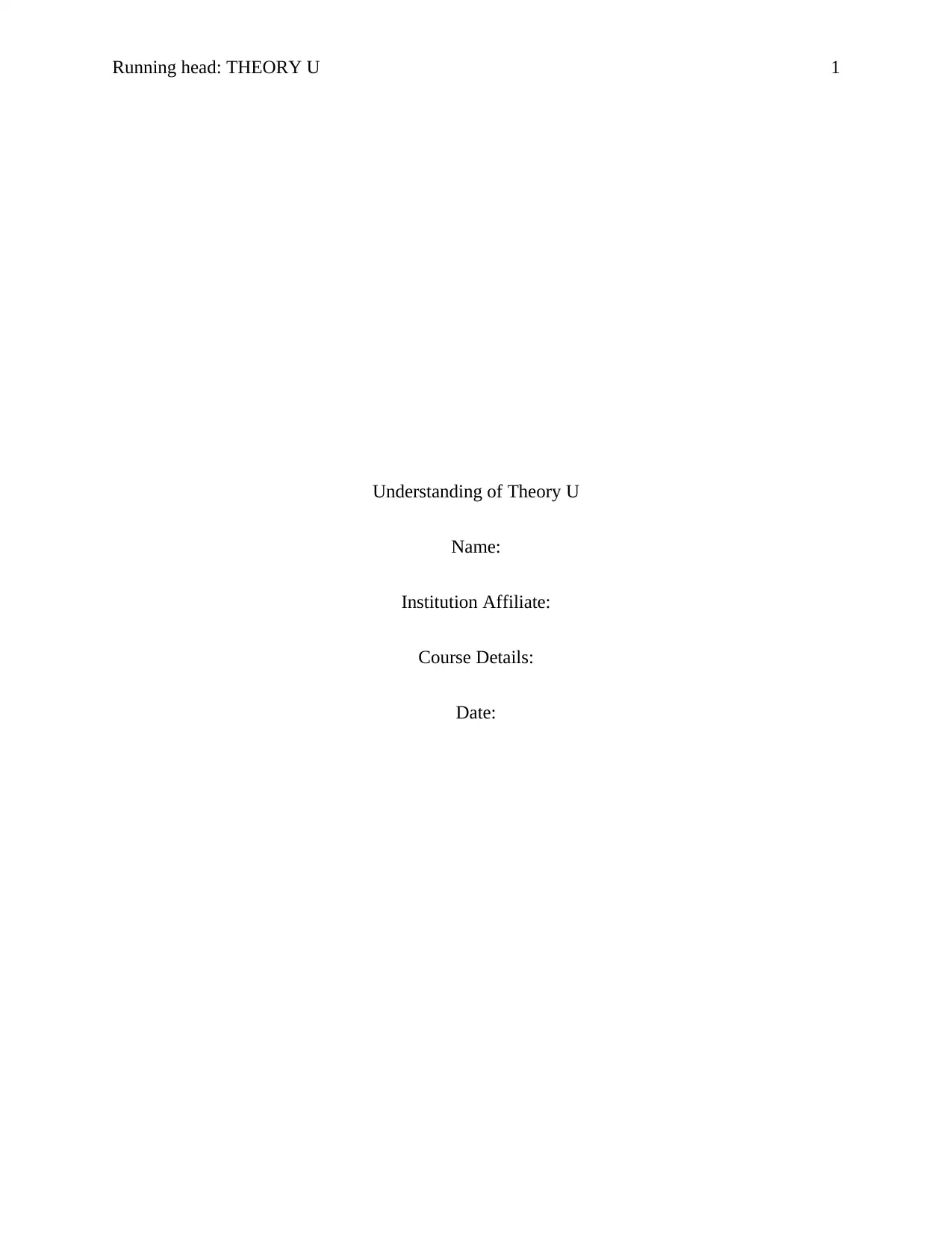
Running head: THEORY U 1
Understanding of Theory U
Name:
Institution Affiliate:
Course Details:
Date:
Understanding of Theory U
Name:
Institution Affiliate:
Course Details:
Date:
Paraphrase This Document
Need a fresh take? Get an instant paraphrase of this document with our AI Paraphraser
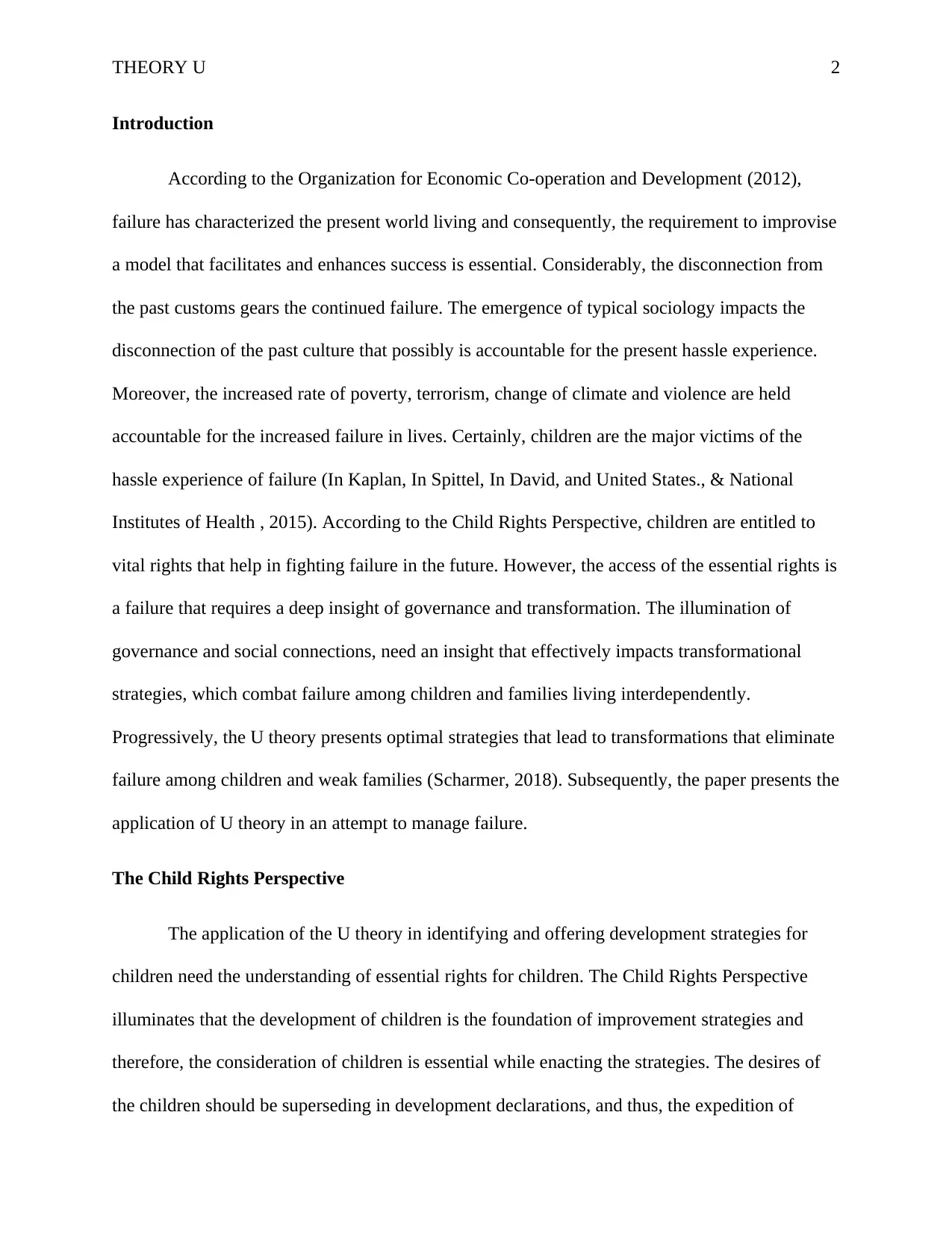
THEORY U 2
Introduction
According to the Organization for Economic Co-operation and Development (2012),
failure has characterized the present world living and consequently, the requirement to improvise
a model that facilitates and enhances success is essential. Considerably, the disconnection from
the past customs gears the continued failure. The emergence of typical sociology impacts the
disconnection of the past culture that possibly is accountable for the present hassle experience.
Moreover, the increased rate of poverty, terrorism, change of climate and violence are held
accountable for the increased failure in lives. Certainly, children are the major victims of the
hassle experience of failure (In Kaplan, In Spittel, In David, and United States., & National
Institutes of Health , 2015). According to the Child Rights Perspective, children are entitled to
vital rights that help in fighting failure in the future. However, the access of the essential rights is
a failure that requires a deep insight of governance and transformation. The illumination of
governance and social connections, need an insight that effectively impacts transformational
strategies, which combat failure among children and families living interdependently.
Progressively, the U theory presents optimal strategies that lead to transformations that eliminate
failure among children and weak families (Scharmer, 2018). Subsequently, the paper presents the
application of U theory in an attempt to manage failure.
The Child Rights Perspective
The application of the U theory in identifying and offering development strategies for
children need the understanding of essential rights for children. The Child Rights Perspective
illuminates that the development of children is the foundation of improvement strategies and
therefore, the consideration of children is essential while enacting the strategies. The desires of
the children should be superseding in development declarations, and thus, the expedition of
Introduction
According to the Organization for Economic Co-operation and Development (2012),
failure has characterized the present world living and consequently, the requirement to improvise
a model that facilitates and enhances success is essential. Considerably, the disconnection from
the past customs gears the continued failure. The emergence of typical sociology impacts the
disconnection of the past culture that possibly is accountable for the present hassle experience.
Moreover, the increased rate of poverty, terrorism, change of climate and violence are held
accountable for the increased failure in lives. Certainly, children are the major victims of the
hassle experience of failure (In Kaplan, In Spittel, In David, and United States., & National
Institutes of Health , 2015). According to the Child Rights Perspective, children are entitled to
vital rights that help in fighting failure in the future. However, the access of the essential rights is
a failure that requires a deep insight of governance and transformation. The illumination of
governance and social connections, need an insight that effectively impacts transformational
strategies, which combat failure among children and families living interdependently.
Progressively, the U theory presents optimal strategies that lead to transformations that eliminate
failure among children and weak families (Scharmer, 2018). Subsequently, the paper presents the
application of U theory in an attempt to manage failure.
The Child Rights Perspective
The application of the U theory in identifying and offering development strategies for
children need the understanding of essential rights for children. The Child Rights Perspective
illuminates that the development of children is the foundation of improvement strategies and
therefore, the consideration of children is essential while enacting the strategies. The desires of
the children should be superseding in development declarations, and thus, the expedition of
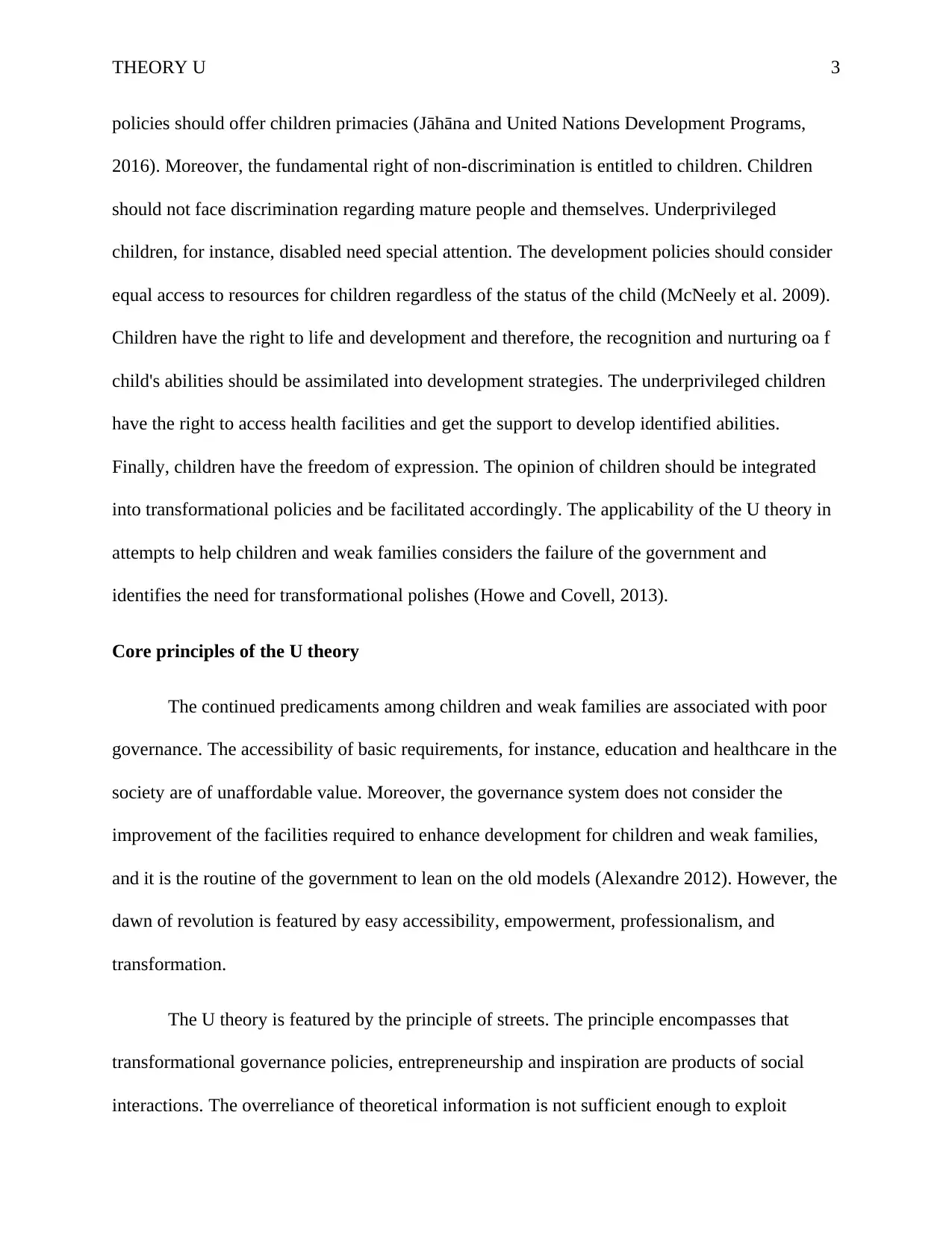
THEORY U 3
policies should offer children primacies (Jāhāna and United Nations Development Programs,
2016). Moreover, the fundamental right of non-discrimination is entitled to children. Children
should not face discrimination regarding mature people and themselves. Underprivileged
children, for instance, disabled need special attention. The development policies should consider
equal access to resources for children regardless of the status of the child (McNeely et al. 2009).
Children have the right to life and development and therefore, the recognition and nurturing oa f
child's abilities should be assimilated into development strategies. The underprivileged children
have the right to access health facilities and get the support to develop identified abilities.
Finally, children have the freedom of expression. The opinion of children should be integrated
into transformational policies and be facilitated accordingly. The applicability of the U theory in
attempts to help children and weak families considers the failure of the government and
identifies the need for transformational polishes (Howe and Covell, 2013).
Core principles of the U theory
The continued predicaments among children and weak families are associated with poor
governance. The accessibility of basic requirements, for instance, education and healthcare in the
society are of unaffordable value. Moreover, the governance system does not consider the
improvement of the facilities required to enhance development for children and weak families,
and it is the routine of the government to lean on the old models (Alexandre 2012). However, the
dawn of revolution is featured by easy accessibility, empowerment, professionalism, and
transformation.
The U theory is featured by the principle of streets. The principle encompasses that
transformational governance policies, entrepreneurship and inspiration are products of social
interactions. The overreliance of theoretical information is not sufficient enough to exploit
policies should offer children primacies (Jāhāna and United Nations Development Programs,
2016). Moreover, the fundamental right of non-discrimination is entitled to children. Children
should not face discrimination regarding mature people and themselves. Underprivileged
children, for instance, disabled need special attention. The development policies should consider
equal access to resources for children regardless of the status of the child (McNeely et al. 2009).
Children have the right to life and development and therefore, the recognition and nurturing oa f
child's abilities should be assimilated into development strategies. The underprivileged children
have the right to access health facilities and get the support to develop identified abilities.
Finally, children have the freedom of expression. The opinion of children should be integrated
into transformational policies and be facilitated accordingly. The applicability of the U theory in
attempts to help children and weak families considers the failure of the government and
identifies the need for transformational polishes (Howe and Covell, 2013).
Core principles of the U theory
The continued predicaments among children and weak families are associated with poor
governance. The accessibility of basic requirements, for instance, education and healthcare in the
society are of unaffordable value. Moreover, the governance system does not consider the
improvement of the facilities required to enhance development for children and weak families,
and it is the routine of the government to lean on the old models (Alexandre 2012). However, the
dawn of revolution is featured by easy accessibility, empowerment, professionalism, and
transformation.
The U theory is featured by the principle of streets. The principle encompasses that
transformational governance policies, entrepreneurship and inspiration are products of social
interactions. The overreliance of theoretical information is not sufficient enough to exploit
⊘ This is a preview!⊘
Do you want full access?
Subscribe today to unlock all pages.

Trusted by 1+ million students worldwide
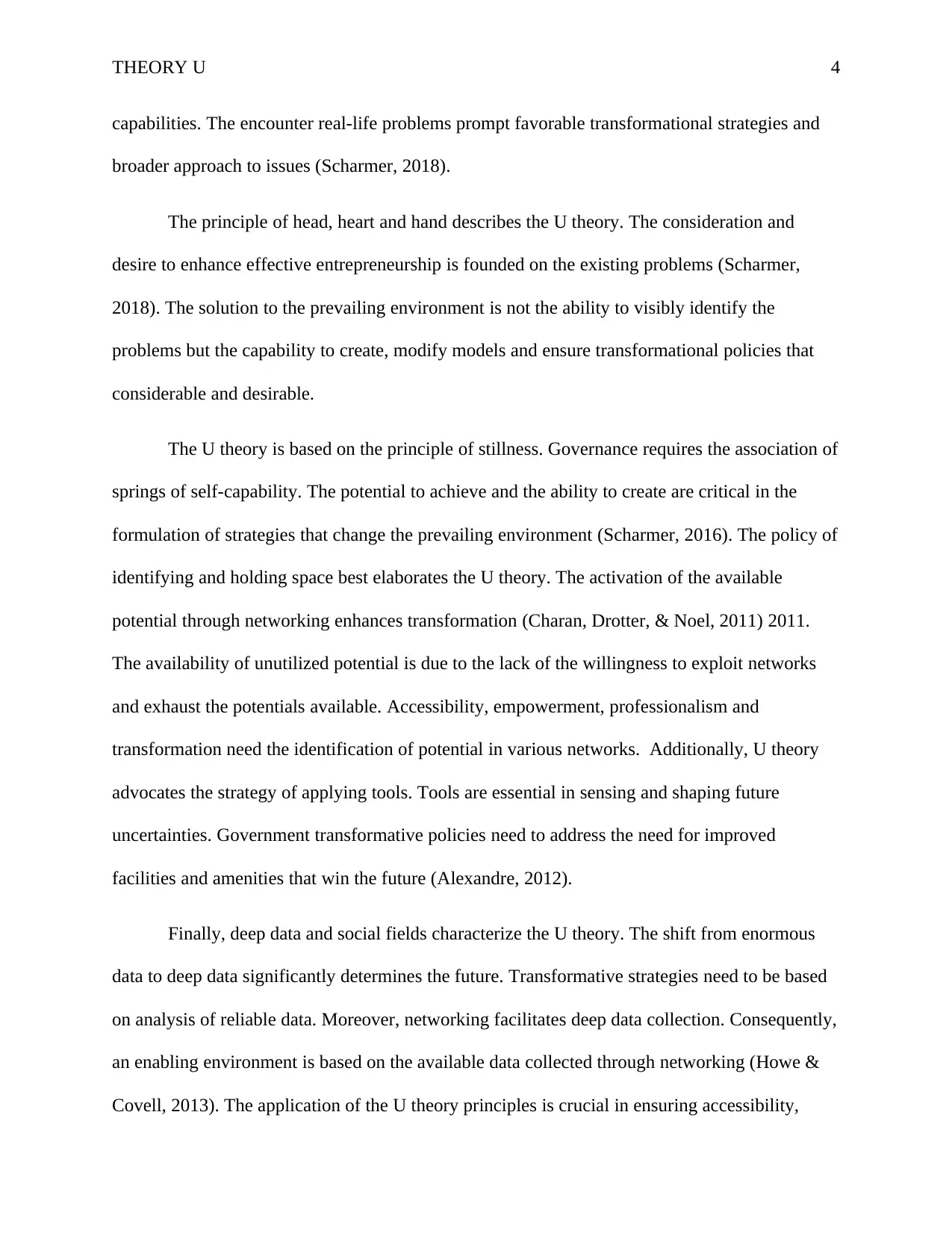
THEORY U 4
capabilities. The encounter real-life problems prompt favorable transformational strategies and
broader approach to issues (Scharmer, 2018).
The principle of head, heart and hand describes the U theory. The consideration and
desire to enhance effective entrepreneurship is founded on the existing problems (Scharmer,
2018). The solution to the prevailing environment is not the ability to visibly identify the
problems but the capability to create, modify models and ensure transformational policies that
considerable and desirable.
The U theory is based on the principle of stillness. Governance requires the association of
springs of self-capability. The potential to achieve and the ability to create are critical in the
formulation of strategies that change the prevailing environment (Scharmer, 2016). The policy of
identifying and holding space best elaborates the U theory. The activation of the available
potential through networking enhances transformation (Charan, Drotter, & Noel, 2011) 2011.
The availability of unutilized potential is due to the lack of the willingness to exploit networks
and exhaust the potentials available. Accessibility, empowerment, professionalism and
transformation need the identification of potential in various networks. Additionally, U theory
advocates the strategy of applying tools. Tools are essential in sensing and shaping future
uncertainties. Government transformative policies need to address the need for improved
facilities and amenities that win the future (Alexandre, 2012).
Finally, deep data and social fields characterize the U theory. The shift from enormous
data to deep data significantly determines the future. Transformative strategies need to be based
on analysis of reliable data. Moreover, networking facilitates deep data collection. Consequently,
an enabling environment is based on the available data collected through networking (Howe &
Covell, 2013). The application of the U theory principles is crucial in ensuring accessibility,
capabilities. The encounter real-life problems prompt favorable transformational strategies and
broader approach to issues (Scharmer, 2018).
The principle of head, heart and hand describes the U theory. The consideration and
desire to enhance effective entrepreneurship is founded on the existing problems (Scharmer,
2018). The solution to the prevailing environment is not the ability to visibly identify the
problems but the capability to create, modify models and ensure transformational policies that
considerable and desirable.
The U theory is based on the principle of stillness. Governance requires the association of
springs of self-capability. The potential to achieve and the ability to create are critical in the
formulation of strategies that change the prevailing environment (Scharmer, 2016). The policy of
identifying and holding space best elaborates the U theory. The activation of the available
potential through networking enhances transformation (Charan, Drotter, & Noel, 2011) 2011.
The availability of unutilized potential is due to the lack of the willingness to exploit networks
and exhaust the potentials available. Accessibility, empowerment, professionalism and
transformation need the identification of potential in various networks. Additionally, U theory
advocates the strategy of applying tools. Tools are essential in sensing and shaping future
uncertainties. Government transformative policies need to address the need for improved
facilities and amenities that win the future (Alexandre, 2012).
Finally, deep data and social fields characterize the U theory. The shift from enormous
data to deep data significantly determines the future. Transformative strategies need to be based
on analysis of reliable data. Moreover, networking facilitates deep data collection. Consequently,
an enabling environment is based on the available data collected through networking (Howe &
Covell, 2013). The application of the U theory principles is crucial in ensuring accessibility,
Paraphrase This Document
Need a fresh take? Get an instant paraphrase of this document with our AI Paraphraser
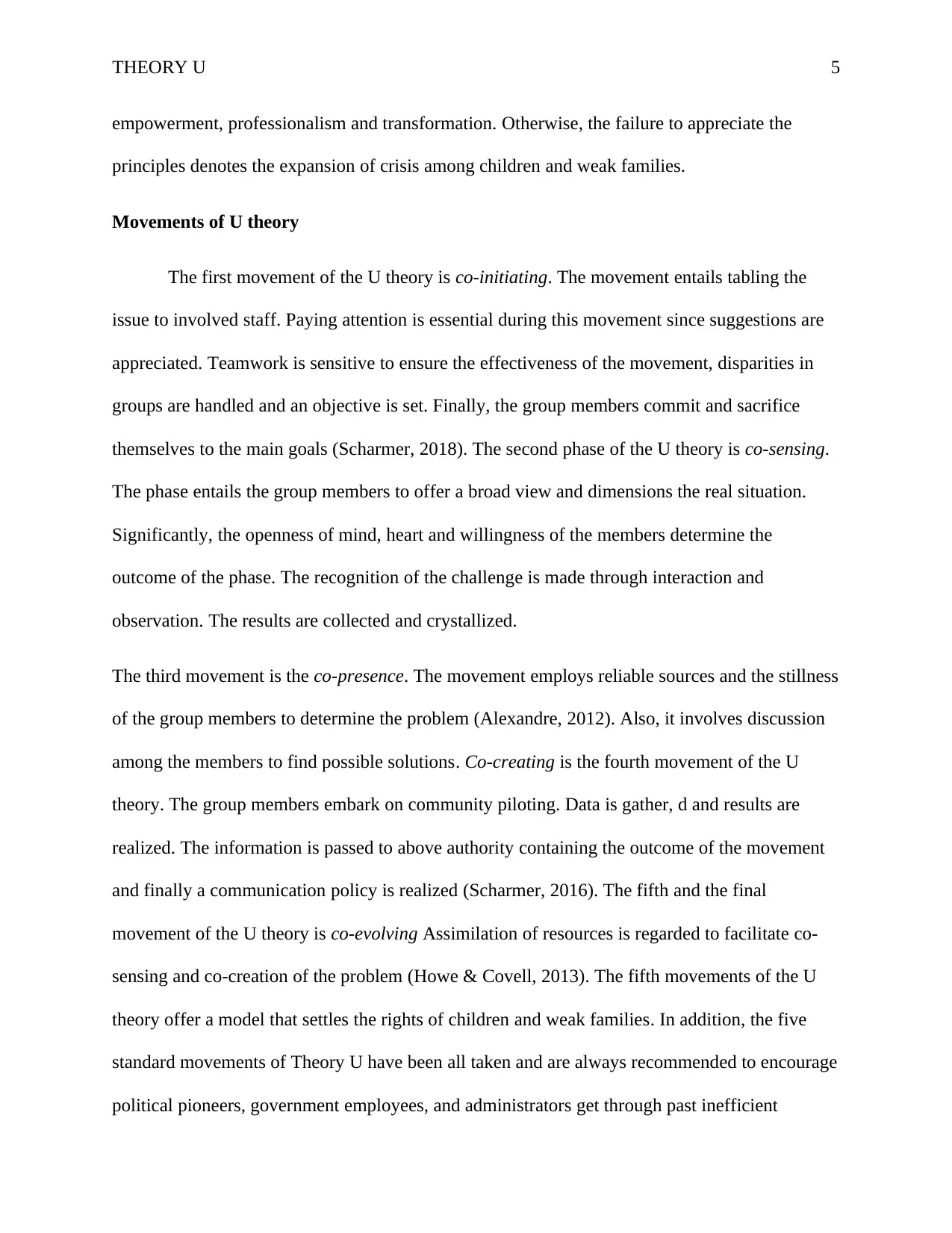
THEORY U 5
empowerment, professionalism and transformation. Otherwise, the failure to appreciate the
principles denotes the expansion of crisis among children and weak families.
Movements of U theory
The first movement of the U theory is co-initiating. The movement entails tabling the
issue to involved staff. Paying attention is essential during this movement since suggestions are
appreciated. Teamwork is sensitive to ensure the effectiveness of the movement, disparities in
groups are handled and an objective is set. Finally, the group members commit and sacrifice
themselves to the main goals (Scharmer, 2018). The second phase of the U theory is co-sensing.
The phase entails the group members to offer a broad view and dimensions the real situation.
Significantly, the openness of mind, heart and willingness of the members determine the
outcome of the phase. The recognition of the challenge is made through interaction and
observation. The results are collected and crystallized.
The third movement is the co-presence. The movement employs reliable sources and the stillness
of the group members to determine the problem (Alexandre, 2012). Also, it involves discussion
among the members to find possible solutions. Co-creating is the fourth movement of the U
theory. The group members embark on community piloting. Data is gather, d and results are
realized. The information is passed to above authority containing the outcome of the movement
and finally a communication policy is realized (Scharmer, 2016). The fifth and the final
movement of the U theory is co-evolving Assimilation of resources is regarded to facilitate co-
sensing and co-creation of the problem (Howe & Covell, 2013). The fifth movements of the U
theory offer a model that settles the rights of children and weak families. In addition, the five
standard movements of Theory U have been all taken and are always recommended to encourage
political pioneers, government employees, and administrators get through past inefficient
empowerment, professionalism and transformation. Otherwise, the failure to appreciate the
principles denotes the expansion of crisis among children and weak families.
Movements of U theory
The first movement of the U theory is co-initiating. The movement entails tabling the
issue to involved staff. Paying attention is essential during this movement since suggestions are
appreciated. Teamwork is sensitive to ensure the effectiveness of the movement, disparities in
groups are handled and an objective is set. Finally, the group members commit and sacrifice
themselves to the main goals (Scharmer, 2018). The second phase of the U theory is co-sensing.
The phase entails the group members to offer a broad view and dimensions the real situation.
Significantly, the openness of mind, heart and willingness of the members determine the
outcome of the phase. The recognition of the challenge is made through interaction and
observation. The results are collected and crystallized.
The third movement is the co-presence. The movement employs reliable sources and the stillness
of the group members to determine the problem (Alexandre, 2012). Also, it involves discussion
among the members to find possible solutions. Co-creating is the fourth movement of the U
theory. The group members embark on community piloting. Data is gather, d and results are
realized. The information is passed to above authority containing the outcome of the movement
and finally a communication policy is realized (Scharmer, 2016). The fifth and the final
movement of the U theory is co-evolving Assimilation of resources is regarded to facilitate co-
sensing and co-creation of the problem (Howe & Covell, 2013). The fifth movements of the U
theory offer a model that settles the rights of children and weak families. In addition, the five
standard movements of Theory U have been all taken and are always recommended to encourage
political pioneers, government employees, and administrators get through past inefficient
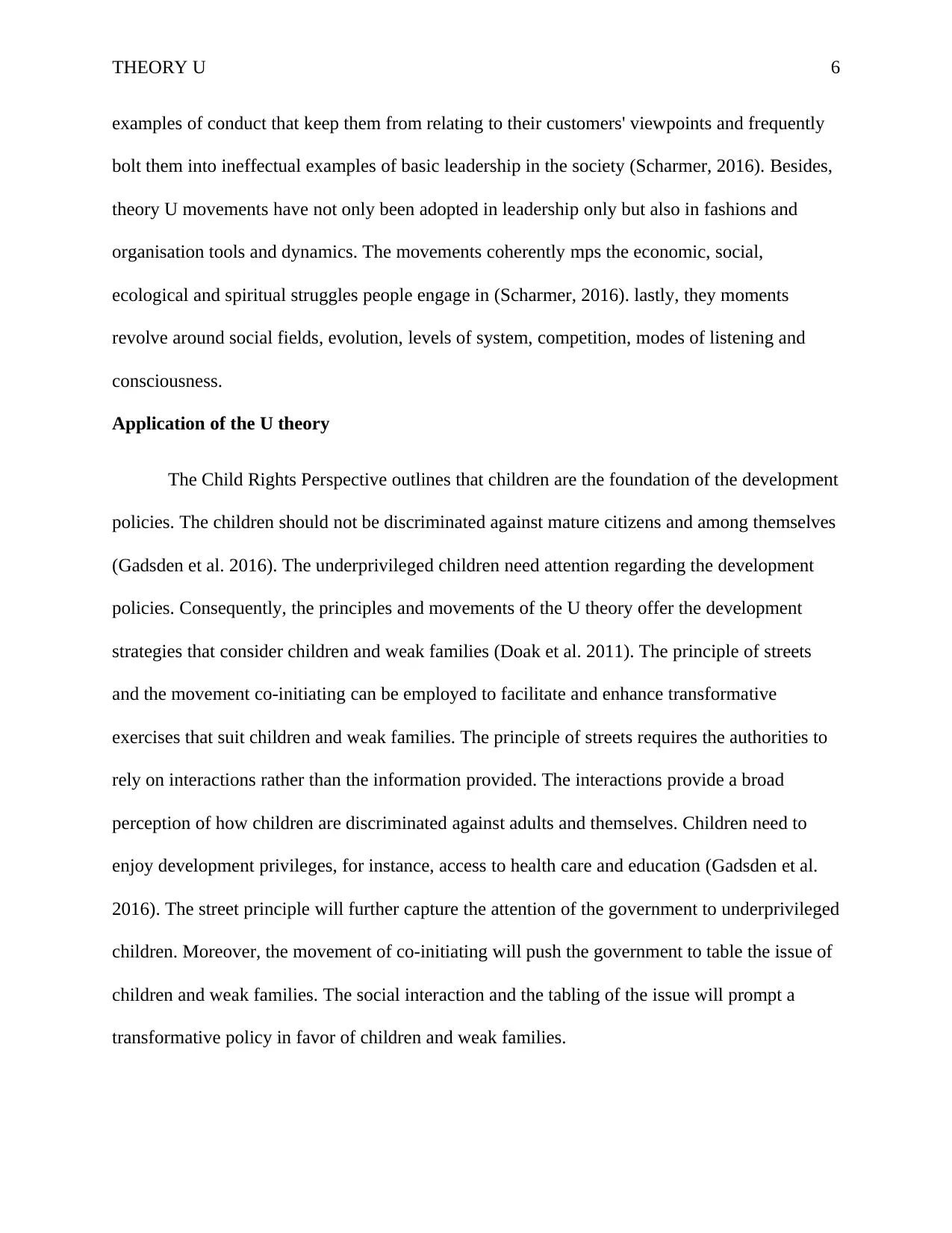
THEORY U 6
examples of conduct that keep them from relating to their customers' viewpoints and frequently
bolt them into ineffectual examples of basic leadership in the society (Scharmer, 2016). Besides,
theory U movements have not only been adopted in leadership only but also in fashions and
organisation tools and dynamics. The movements coherently mps the economic, social,
ecological and spiritual struggles people engage in (Scharmer, 2016). lastly, they moments
revolve around social fields, evolution, levels of system, competition, modes of listening and
consciousness.
Application of the U theory
The Child Rights Perspective outlines that children are the foundation of the development
policies. The children should not be discriminated against mature citizens and among themselves
(Gadsden et al. 2016). The underprivileged children need attention regarding the development
policies. Consequently, the principles and movements of the U theory offer the development
strategies that consider children and weak families (Doak et al. 2011). The principle of streets
and the movement co-initiating can be employed to facilitate and enhance transformative
exercises that suit children and weak families. The principle of streets requires the authorities to
rely on interactions rather than the information provided. The interactions provide a broad
perception of how children are discriminated against adults and themselves. Children need to
enjoy development privileges, for instance, access to health care and education (Gadsden et al.
2016). The street principle will further capture the attention of the government to underprivileged
children. Moreover, the movement of co-initiating will push the government to table the issue of
children and weak families. The social interaction and the tabling of the issue will prompt a
transformative policy in favor of children and weak families.
examples of conduct that keep them from relating to their customers' viewpoints and frequently
bolt them into ineffectual examples of basic leadership in the society (Scharmer, 2016). Besides,
theory U movements have not only been adopted in leadership only but also in fashions and
organisation tools and dynamics. The movements coherently mps the economic, social,
ecological and spiritual struggles people engage in (Scharmer, 2016). lastly, they moments
revolve around social fields, evolution, levels of system, competition, modes of listening and
consciousness.
Application of the U theory
The Child Rights Perspective outlines that children are the foundation of the development
policies. The children should not be discriminated against mature citizens and among themselves
(Gadsden et al. 2016). The underprivileged children need attention regarding the development
policies. Consequently, the principles and movements of the U theory offer the development
strategies that consider children and weak families (Doak et al. 2011). The principle of streets
and the movement co-initiating can be employed to facilitate and enhance transformative
exercises that suit children and weak families. The principle of streets requires the authorities to
rely on interactions rather than the information provided. The interactions provide a broad
perception of how children are discriminated against adults and themselves. Children need to
enjoy development privileges, for instance, access to health care and education (Gadsden et al.
2016). The street principle will further capture the attention of the government to underprivileged
children. Moreover, the movement of co-initiating will push the government to table the issue of
children and weak families. The social interaction and the tabling of the issue will prompt a
transformative policy in favor of children and weak families.
⊘ This is a preview!⊘
Do you want full access?
Subscribe today to unlock all pages.

Trusted by 1+ million students worldwide
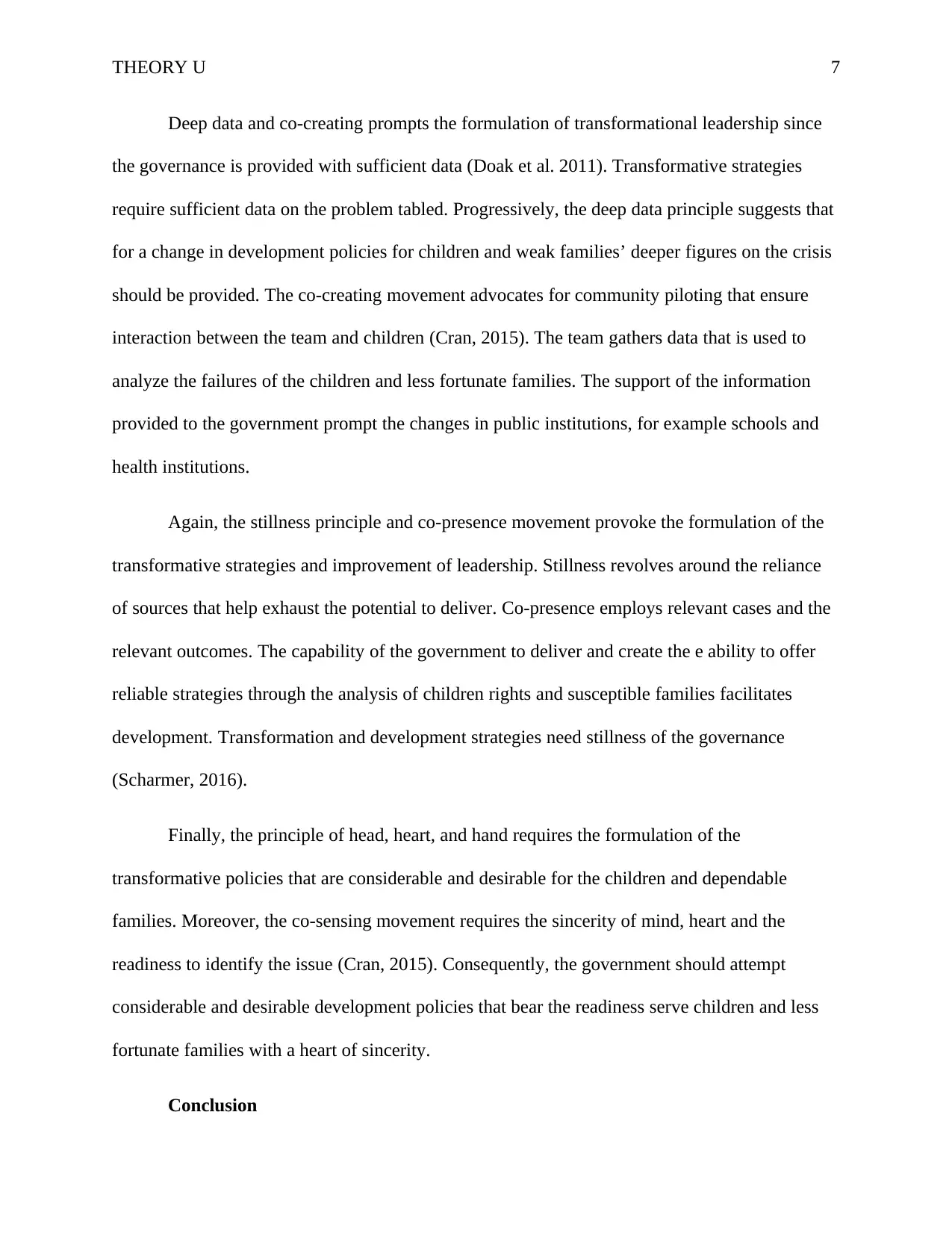
THEORY U 7
Deep data and co-creating prompts the formulation of transformational leadership since
the governance is provided with sufficient data (Doak et al. 2011). Transformative strategies
require sufficient data on the problem tabled. Progressively, the deep data principle suggests that
for a change in development policies for children and weak families’ deeper figures on the crisis
should be provided. The co-creating movement advocates for community piloting that ensure
interaction between the team and children (Cran, 2015). The team gathers data that is used to
analyze the failures of the children and less fortunate families. The support of the information
provided to the government prompt the changes in public institutions, for example schools and
health institutions.
Again, the stillness principle and co-presence movement provoke the formulation of the
transformative strategies and improvement of leadership. Stillness revolves around the reliance
of sources that help exhaust the potential to deliver. Co-presence employs relevant cases and the
relevant outcomes. The capability of the government to deliver and create the e ability to offer
reliable strategies through the analysis of children rights and susceptible families facilitates
development. Transformation and development strategies need stillness of the governance
(Scharmer, 2016).
Finally, the principle of head, heart, and hand requires the formulation of the
transformative policies that are considerable and desirable for the children and dependable
families. Moreover, the co-sensing movement requires the sincerity of mind, heart and the
readiness to identify the issue (Cran, 2015). Consequently, the government should attempt
considerable and desirable development policies that bear the readiness serve children and less
fortunate families with a heart of sincerity.
Conclusion
Deep data and co-creating prompts the formulation of transformational leadership since
the governance is provided with sufficient data (Doak et al. 2011). Transformative strategies
require sufficient data on the problem tabled. Progressively, the deep data principle suggests that
for a change in development policies for children and weak families’ deeper figures on the crisis
should be provided. The co-creating movement advocates for community piloting that ensure
interaction between the team and children (Cran, 2015). The team gathers data that is used to
analyze the failures of the children and less fortunate families. The support of the information
provided to the government prompt the changes in public institutions, for example schools and
health institutions.
Again, the stillness principle and co-presence movement provoke the formulation of the
transformative strategies and improvement of leadership. Stillness revolves around the reliance
of sources that help exhaust the potential to deliver. Co-presence employs relevant cases and the
relevant outcomes. The capability of the government to deliver and create the e ability to offer
reliable strategies through the analysis of children rights and susceptible families facilitates
development. Transformation and development strategies need stillness of the governance
(Scharmer, 2016).
Finally, the principle of head, heart, and hand requires the formulation of the
transformative policies that are considerable and desirable for the children and dependable
families. Moreover, the co-sensing movement requires the sincerity of mind, heart and the
readiness to identify the issue (Cran, 2015). Consequently, the government should attempt
considerable and desirable development policies that bear the readiness serve children and less
fortunate families with a heart of sincerity.
Conclusion
Paraphrase This Document
Need a fresh take? Get an instant paraphrase of this document with our AI Paraphraser
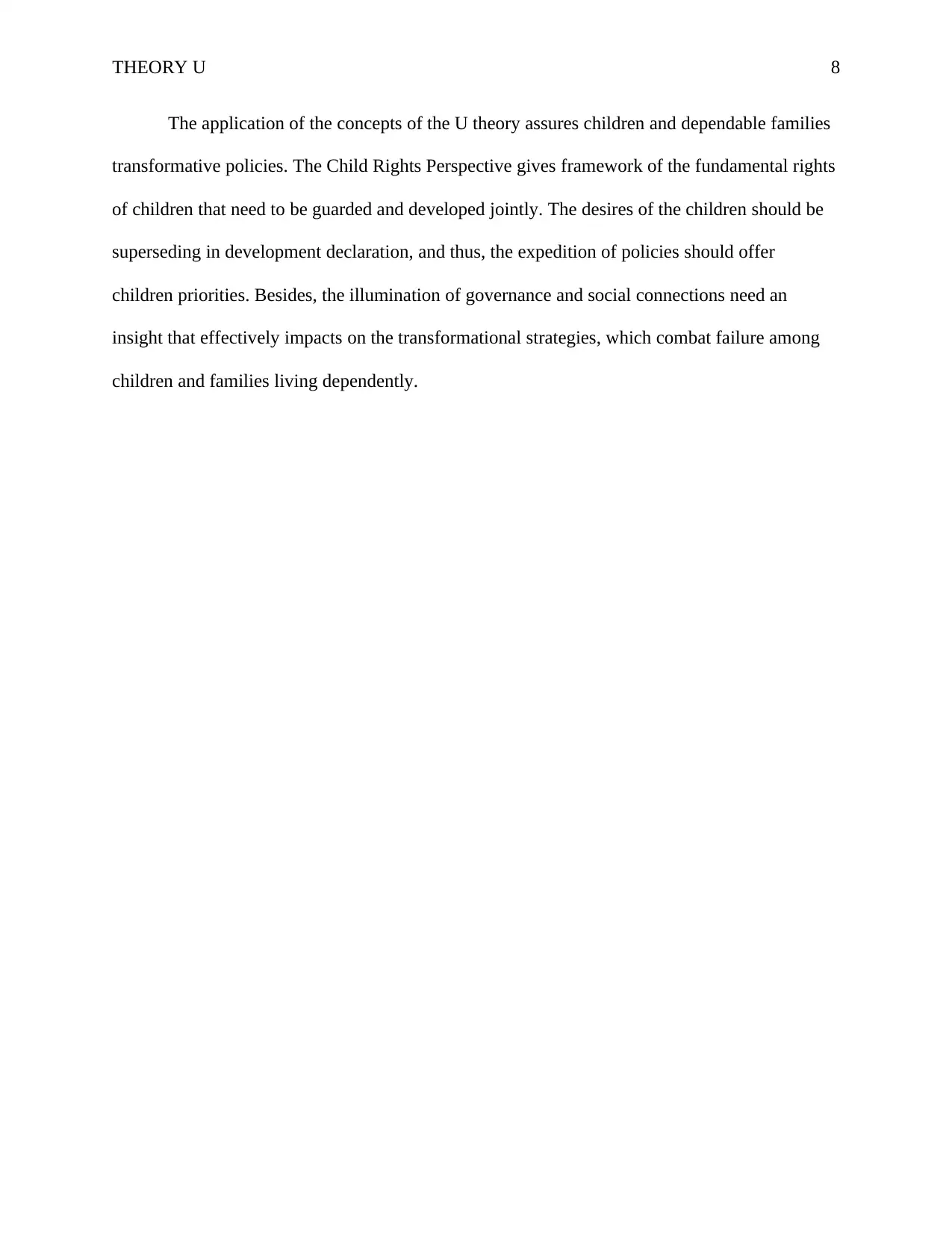
THEORY U 8
The application of the concepts of the U theory assures children and dependable families
transformative policies. The Child Rights Perspective gives framework of the fundamental rights
of children that need to be guarded and developed jointly. The desires of the children should be
superseding in development declaration, and thus, the expedition of policies should offer
children priorities. Besides, the illumination of governance and social connections need an
insight that effectively impacts on the transformational strategies, which combat failure among
children and families living dependently.
The application of the concepts of the U theory assures children and dependable families
transformative policies. The Child Rights Perspective gives framework of the fundamental rights
of children that need to be guarded and developed jointly. The desires of the children should be
superseding in development declaration, and thus, the expedition of policies should offer
children priorities. Besides, the illumination of governance and social connections need an
insight that effectively impacts on the transformational strategies, which combat failure among
children and families living dependently.
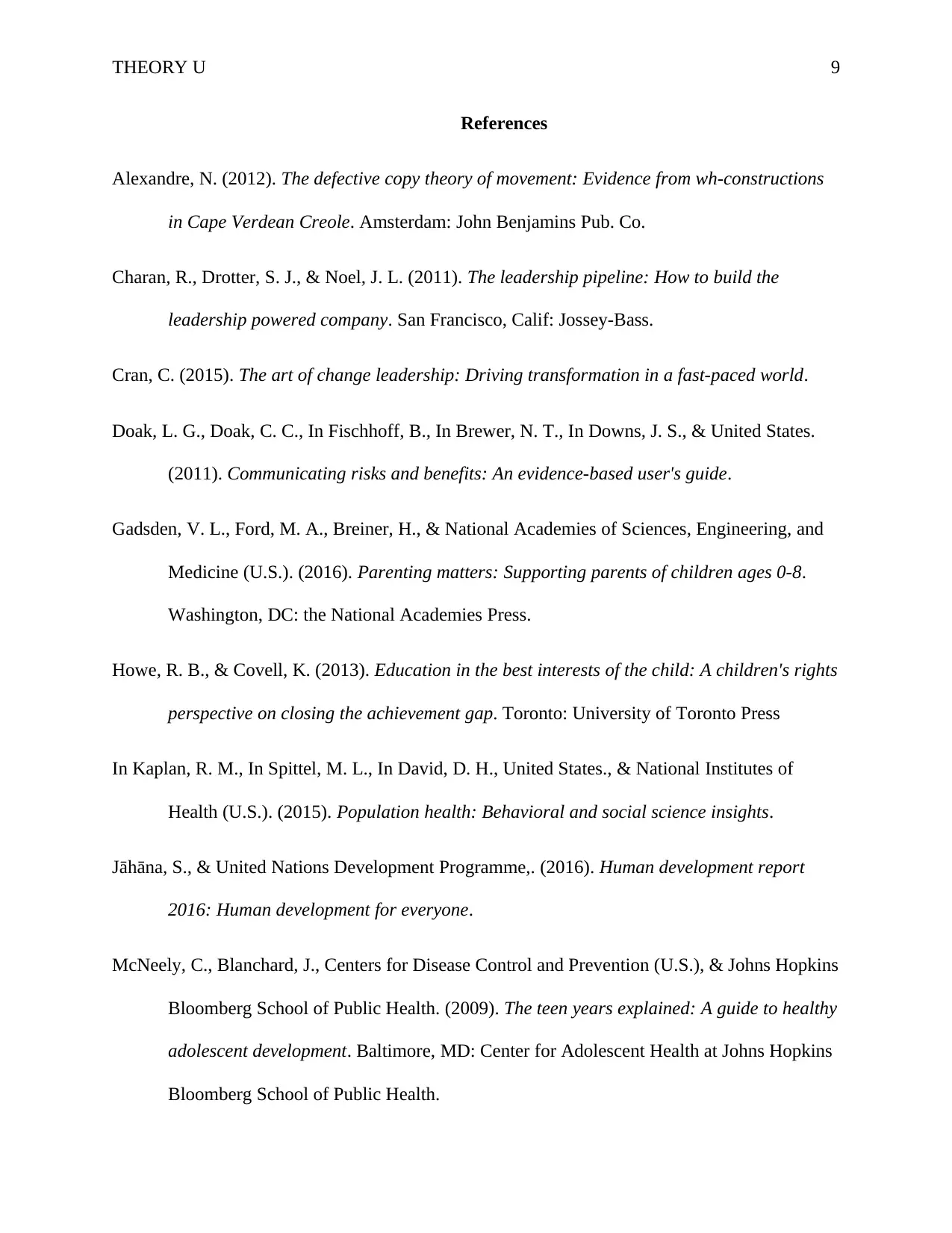
THEORY U 9
References
Alexandre, N. (2012). The defective copy theory of movement: Evidence from wh-constructions
in Cape Verdean Creole. Amsterdam: John Benjamins Pub. Co.
Charan, R., Drotter, S. J., & Noel, J. L. (2011). The leadership pipeline: How to build the
leadership powered company. San Francisco, Calif: Jossey-Bass.
Cran, C. (2015). The art of change leadership: Driving transformation in a fast-paced world.
Doak, L. G., Doak, C. C., In Fischhoff, B., In Brewer, N. T., In Downs, J. S., & United States.
(2011). Communicating risks and benefits: An evidence-based user's guide.
Gadsden, V. L., Ford, M. A., Breiner, H., & National Academies of Sciences, Engineering, and
Medicine (U.S.). (2016). Parenting matters: Supporting parents of children ages 0-8.
Washington, DC: the National Academies Press.
Howe, R. B., & Covell, K. (2013). Education in the best interests of the child: A children's rights
perspective on closing the achievement gap. Toronto: University of Toronto Press
In Kaplan, R. M., In Spittel, M. L., In David, D. H., United States., & National Institutes of
Health (U.S.). (2015). Population health: Behavioral and social science insights.
Jāhāna, S., & United Nations Development Programme,. (2016). Human development report
2016: Human development for everyone.
McNeely, C., Blanchard, J., Centers for Disease Control and Prevention (U.S.), & Johns Hopkins
Bloomberg School of Public Health. (2009). The teen years explained: A guide to healthy
adolescent development. Baltimore, MD: Center for Adolescent Health at Johns Hopkins
Bloomberg School of Public Health.
References
Alexandre, N. (2012). The defective copy theory of movement: Evidence from wh-constructions
in Cape Verdean Creole. Amsterdam: John Benjamins Pub. Co.
Charan, R., Drotter, S. J., & Noel, J. L. (2011). The leadership pipeline: How to build the
leadership powered company. San Francisco, Calif: Jossey-Bass.
Cran, C. (2015). The art of change leadership: Driving transformation in a fast-paced world.
Doak, L. G., Doak, C. C., In Fischhoff, B., In Brewer, N. T., In Downs, J. S., & United States.
(2011). Communicating risks and benefits: An evidence-based user's guide.
Gadsden, V. L., Ford, M. A., Breiner, H., & National Academies of Sciences, Engineering, and
Medicine (U.S.). (2016). Parenting matters: Supporting parents of children ages 0-8.
Washington, DC: the National Academies Press.
Howe, R. B., & Covell, K. (2013). Education in the best interests of the child: A children's rights
perspective on closing the achievement gap. Toronto: University of Toronto Press
In Kaplan, R. M., In Spittel, M. L., In David, D. H., United States., & National Institutes of
Health (U.S.). (2015). Population health: Behavioral and social science insights.
Jāhāna, S., & United Nations Development Programme,. (2016). Human development report
2016: Human development for everyone.
McNeely, C., Blanchard, J., Centers for Disease Control and Prevention (U.S.), & Johns Hopkins
Bloomberg School of Public Health. (2009). The teen years explained: A guide to healthy
adolescent development. Baltimore, MD: Center for Adolescent Health at Johns Hopkins
Bloomberg School of Public Health.
⊘ This is a preview!⊘
Do you want full access?
Subscribe today to unlock all pages.

Trusted by 1+ million students worldwide
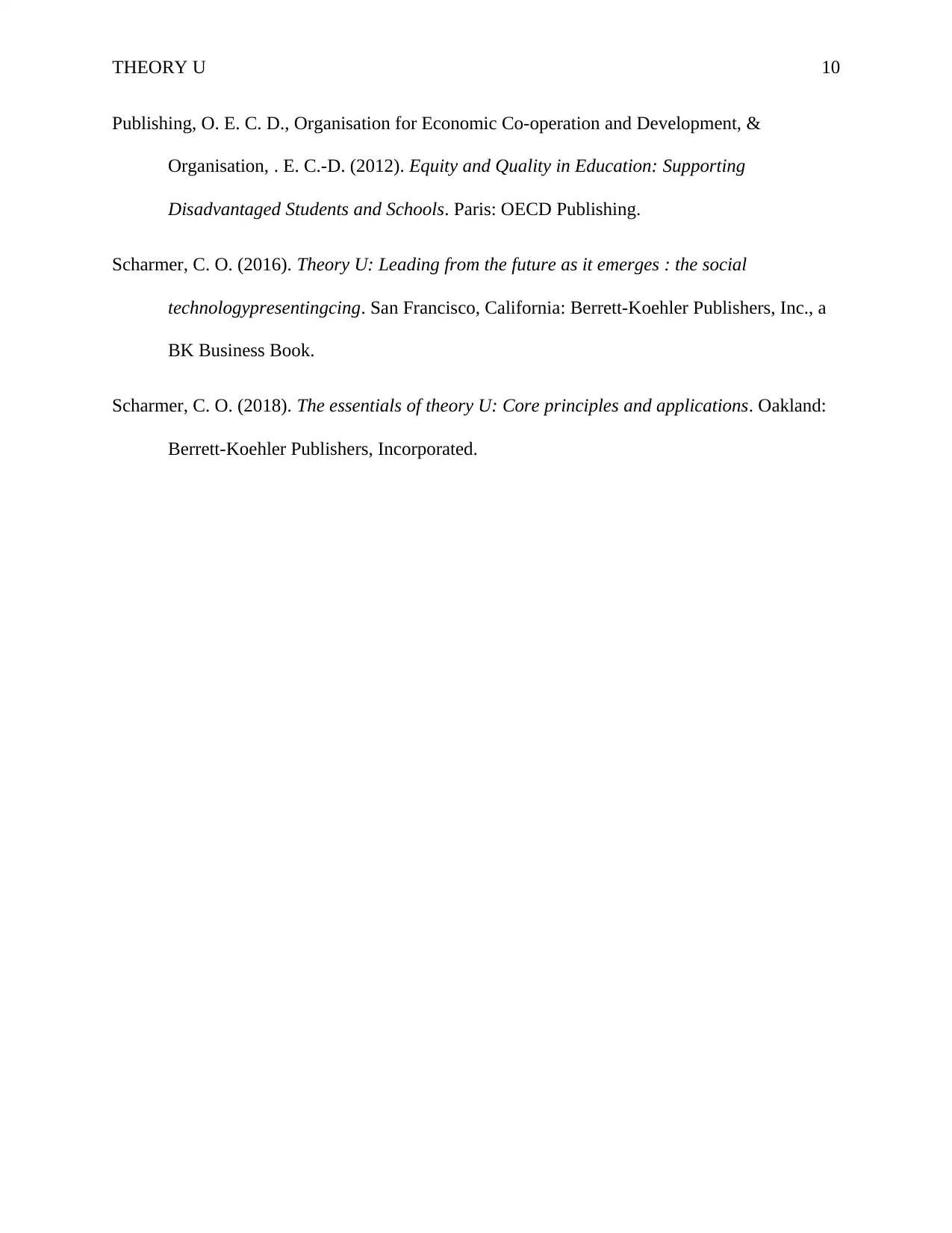
THEORY U 10
Publishing, O. E. C. D., Organisation for Economic Co-operation and Development, &
Organisation, . E. C.-D. (2012). Equity and Quality in Education: Supporting
Disadvantaged Students and Schools. Paris: OECD Publishing.
Scharmer, C. O. (2016). Theory U: Leading from the future as it emerges : the social
technologypresentingcing. San Francisco, California: Berrett-Koehler Publishers, Inc., a
BK Business Book.
Scharmer, C. O. (2018). The essentials of theory U: Core principles and applications. Oakland:
Berrett-Koehler Publishers, Incorporated.
Publishing, O. E. C. D., Organisation for Economic Co-operation and Development, &
Organisation, . E. C.-D. (2012). Equity and Quality in Education: Supporting
Disadvantaged Students and Schools. Paris: OECD Publishing.
Scharmer, C. O. (2016). Theory U: Leading from the future as it emerges : the social
technologypresentingcing. San Francisco, California: Berrett-Koehler Publishers, Inc., a
BK Business Book.
Scharmer, C. O. (2018). The essentials of theory U: Core principles and applications. Oakland:
Berrett-Koehler Publishers, Incorporated.
1 out of 10
Your All-in-One AI-Powered Toolkit for Academic Success.
+13062052269
info@desklib.com
Available 24*7 on WhatsApp / Email
![[object Object]](/_next/static/media/star-bottom.7253800d.svg)
Unlock your academic potential
Copyright © 2020–2025 A2Z Services. All Rights Reserved. Developed and managed by ZUCOL.
